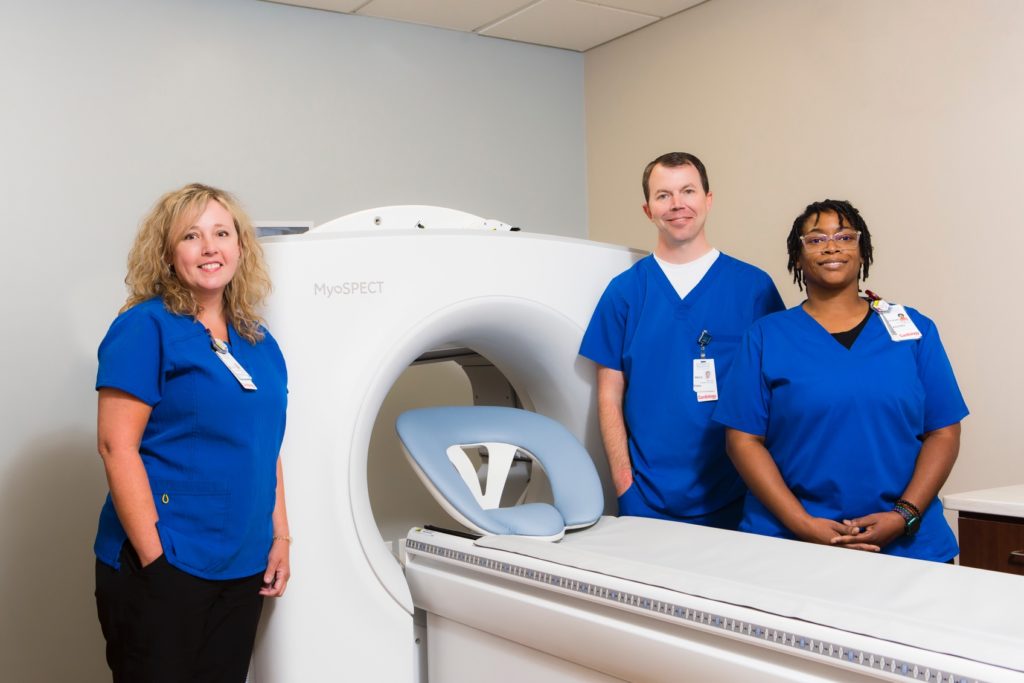

The MyoSPECT, which was installed in early April, is designed to view cardiac anatomy and pathology with great clarity, exceptional patient comfort, and provide clinicians with the information they need to help improve patient outcomes. Compared to previously-utilized technology, this device offers a wider table and a 76 percent increase in field-of-view volume, providing clinicians greater positioning flexibility. Patients who have traditionally been too weak to sit up through an entire exam or others with high body mass indexes (BMIs) will be able to utilize this new machine.
In addition to now being able to serve an increased patient base, this technology also provides a more complete picture of the heart’s anatomy and pathology by using nine camera heads, most SPECT devices only use six. Patients will also experience shorter scan times and increased comfort with Smart Positioning, which offers positioning prompts and recommendations to optimize the patient’s comfort level.
“We have worked strategically to stay on the cutting edge of technology and practices and have implemented four major pieces of equipment in the last year,” said Colquitt Regional President and CEO Jim Matney. “To be the first hospital in the state of Georgia to introduce the MyoSPECT is a great accomplishment for our team and a huge win for our patients. This further displays our commitment to bringing top-of-the-line, modern healthcare machinery right to our patients’ backyards.”
Patients who are referred to the MyoSPECT will first have a nuclear stress test completed, where the patient will have their heart scanned and blood flow measured while they are at rest and after physical exertion, showing areas with poor blood flow and/or heart damage.
When the patient arrives, a technician will insert an intravenous (IV) line into the arm and inject a radioactive dye. They will be scanned with the MyoSPECT to acquire baseline images while the heart is at rest. Once rest images are completed, the patient is transferred to the stress area to be connected to an electrocardiogram (EKG) and blood pressure machine.
An exercise stress test is then conducted, where the patient walks on a treadmill, slowly first, then increasing difficulty and speed throughout the test. The patient is injected with another round of radioactive dye when the heart rate peaks. After about 20-40 minutes, they will lie still on a table and have a second set of images made of the heart muscle.
The radioactive dye will show any areas of the heart receiving inadequate blood flow. Results are then sent to the referring physician and a treatment plan, if needed, will be discussed with the patient.
“According to the CDC, one in every four deaths in the United States is directly related to heart disease,” said Hospital Authority Chairman Richard E. Turner, Jr. “With the prevalence of heart-related health issues continuing to increase, we understand the urgency in ensuring that our patients have timely access to the most up-to-date technology available in the cardiovascular sphere.”
For more information, please contact the Hufstetler Heart Center at 229-890-9060.
###
Caption: Colquitt Regional Medical Center recently announced the addition of the GE MyoSPECT to the Hufstetler Heart Center. This single-photon emission computerized tomography (SPECT) device scans the anatomy of the heart and is the first MyoSPECT to be introduced in the State of Georgia. Pictured with the MyoSPECT, from left, is Miranda Dalton, RT(R), CNMT, Director of Cardiology Services Gary Mackie, RDCS, and Javon Clark RT(R)(N).







